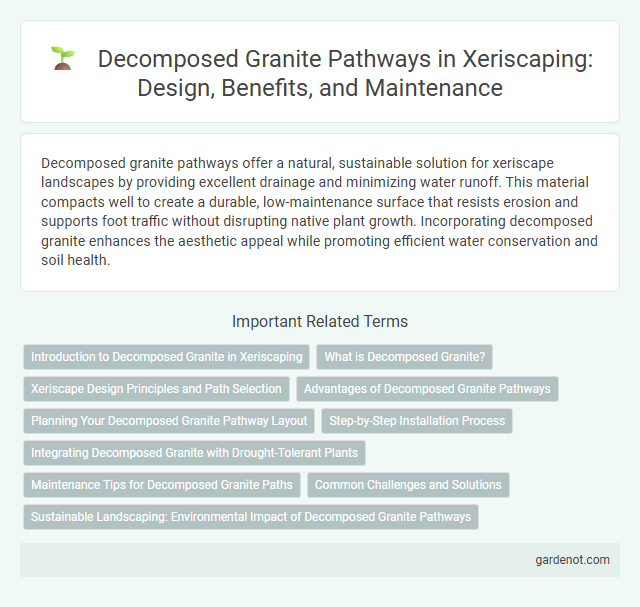Decomposed granite pathways offer a natural, sustainable solution for xeriscape landscapes by providing excellent drainage and minimizing water runoff. This material compacts well to create a durable, low-maintenance surface that resists erosion and supports foot traffic without disrupting native plant growth. Incorporating decomposed granite enhances the aesthetic appeal while promoting efficient water conservation and soil health.
Introduction to Decomposed Granite in Xeriscaping
Decomposed granite is a popular choice for xeriscaping pathways due to its excellent drainage and natural, earthy appearance that complements drought-tolerant landscapes. This material consists of finely crushed granite rock that compacts well to create a stable, permeable surface ideal for reducing water runoff. Its durability and low maintenance requirements make decomposed granite a sustainable option for creating functional, eco-friendly walkways in water-efficient garden designs.
What is Decomposed Granite?
Decomposed granite is a natural material made from weathered granite that has broken down into small, loose granules. It is commonly used in xeriscaping for pathways due to its excellent drainage properties and low maintenance requirements. This porous, stable surface helps conserve water while providing a durable, natural-looking walkway ideal for drought-tolerant landscapes.
Xeriscape Design Principles and Path Selection
Decomposed granite pathways align with xeriscape design principles by promoting water conservation through permeable surfaces that reduce runoff and encourage soil infiltration. Selecting decomposed granite for pathways enhances sustainable landscaping by using natural, drought-tolerant materials that withstand local climate conditions. Incorporating this material supports efficient water use, minimizes maintenance, and preserves the integrity of xeriscape environments.
Advantages of Decomposed Granite Pathways
Decomposed granite pathways offer excellent water permeability, reducing runoff and promoting groundwater recharge, essential for xeriscape landscapes. Their natural appearance blends seamlessly with arid garden designs, providing a durable, low-maintenance surface resistant to erosion and weed growth. The material's affordability and ease of installation make decomposed granite an efficient choice for sustainable, eco-friendly garden paths.
Planning Your Decomposed Granite Pathway Layout
Planning your decomposed granite pathway layout involves carefully mapping the desired path to ensure smooth flow and accessibility throughout the xeriscape garden. Consider factors such as natural drainage, sunlight exposure, and proximity to key landscape features like drought-tolerant plants and rock formations. Incorporating gentle curves and varying widths enhances visual interest while maintaining functionality in low-water landscaping designs.
Step-by-Step Installation Process
Decomposed granite pathways require careful preparation, starting with clearing the area and installing a weed barrier to ensure durability. Next, evenly spread a 3-4 inch layer of decomposed granite and compact it using a plate compactor for stability and smoothness. Finally, apply a sealant or stabilizer to bind the material, enhancing longevity and resistance to erosion in xeriscape landscapes.
Integrating Decomposed Granite with Drought-Tolerant Plants
Decomposed granite pathways provide excellent water permeability and natural aesthetics, making them ideal for xeriscape designs with drought-tolerant plants. Combining decomposed granite with native succulents, agave, and ornamental grasses enhances soil drainage while minimizing water usage. This integration promotes sustainable landscaping by reducing irrigation needs and preventing soil erosion in arid environments.
Maintenance Tips for Decomposed Granite Paths
Decomposed granite pathways require regular raking to maintain a smooth, even surface that prevents erosion and compaction. Applying a stabilizer or polymer binder helps reduce dust and washouts while extending the path's lifespan. Periodic topping with fresh decomposed granite ensures optimal drainage and preserves the pathway's aesthetic appeal in xeriscape landscapes.
Common Challenges and Solutions
Decomposed granite pathways often face challenges such as erosion, compaction, and weed growth, which can compromise durability and aesthetics. Proper installation with a compacted base layer, use of stabilizers or binders, and regular maintenance like weed control effectively address these issues. Implementing edging barriers and ensuring adequate drainage further enhance the pathway's longevity and functionality in xeriscape gardens.
Sustainable Landscaping: Environmental Impact of Decomposed Granite Pathways
Decomposed granite pathways offer a sustainable landscaping solution by reducing water runoff and promoting natural drainage, which helps prevent soil erosion and conserves water resources. Their permeable surface supports groundwater recharge, enhances urban heat island mitigation, and minimizes stormwater pollution compared to traditional concrete or asphalt paths. Decomposed granite is a low-impact material derived from finely weathered granite, making it an eco-friendly choice that reduces carbon footprint through minimal processing and transportation requirements.
Decomposed granite pathway Infographic

 gardenot.com
gardenot.com